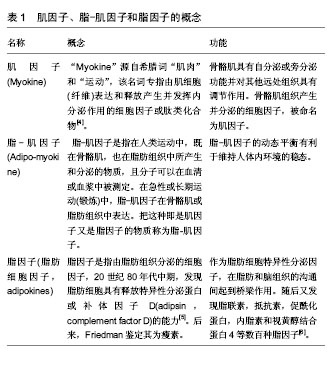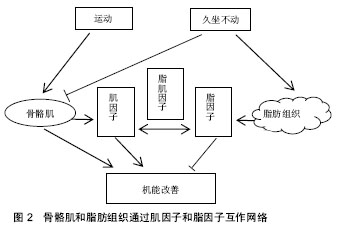| [1] Ruderman NB, Keller C, Richard AM, et al. Interleukin-6 regulation of AMP-activated protein kinase. Potential role in the systemic response to exercise and prevention of the metabolic syndrome. Diabetes.2006; 55 Suppl 2:S48-S54. [2] Wang J, Liu R, Hawkins M, et al. A nutrient-sensing pathway regulates leptin gene expression in muscle and fat. Nature.1998;393(6686): 684-688. [3] Hecksteden A, Wegmann M, Steffen A, et al. Irisin and exercise training in humans - results from a randomized controlled training trial. BMC Med.2013; 11:235. [4] Pedersen BK, Steensberg A, Fischer C, et al. Searching for the exercise factor: is IL-6 a candidate?. J Muscle Res Cell Motil.2003; 24(2-3):113-119. [5] Cook KS, Min HY, Johnson D, et al. Adipsin: a circulating serine protease homolog secreted by adipose tissue and sciatic nerve. Science.1987;237(4813):402-405. [6] Scherer PE. Adipose tissue: from lipid storage compartment to endocrine organ. Diabetes.2006; 55(6):1537-1545. [7] Eckardt K, Gorgens SW, Raschke S, et al. Myokines in insulin resistance and type 2 diabetes. Diabetologia. 2014;57(6): 1087-1099. [8] Pedersen BK. Muscle as a Secretory Organ. Compr Physiol. 2013;3(3):1337-1362. [9] Wolin KY, Yan Y, Colditz GA, et al. Physical activity and colon cancer prevention: a meta-analysis. Br J Cancer. 2009;100(4): 611-616. [10] Monninkhof EM, Elias SG, Vlems FA, et al. Physical activity and breast cancer - A systematic review. Epidemiology. 2007;18(1): 137-157. [11] Borer KT. Physical activity in the prevention and amelioration of osteoporosis in women - Interaction of mechanical, hormonal and dietary factors. Sports Med. 2005;35(9):779-830. [12] Goergens SW, Eckardt K, Jensen J, et al. Exercise and Regulation of Adipokine and Myokine Production[M]//Bouchard C. Progress in Molecular Biology and Translational Science. 2015:313-336. [13] 陈明.读《素问•阴阳应象大论》札记五则[J].中医函授通讯,1995,(2): 2-3.[14] Pedersen BK, Febbraio MA. Muscles, exercise and obesity: skeletal muscle as a secretory organ. Nat Rev Endocrinol. 2012;8(8):457-465. [15] Rodriguez A, Ezquerro S, Mendez-Gimenez L, et al. Revisiting the adipocyte: a model for integration of cytokine signaling in the regulation of energy metabolism. Am J Physiol Endocrinol Metab. 2015;309(8):E691-714. [16] Richter EA, Hargreaves M. Exercise, GLUT4, and skeletal muscle glucose uptake.Physiol Rev. 2013;93(3):993-1017. [17] Little JP, Gillen JB, Percival ME, et al. Low-volume high-intensity interval training reduces hyperglycemia and increases muscle mitochondrial capacity in patients with type 2 diabetes. J Appl Physiol (1985). 2011;111(6):1554-1560. [18] Jeukendrup AE. Regulation of fat metabolism in skeletal muscle[M]//Klimes I, Sebokova E, Howard B V, et al. Annals of the New York Academy of Sciences. 2002:217-235. [19] Hoene M, Weigert C. The role of interleukin-6 in insulin resistance, body fat distribution and energy balance. Obes Rev. 2008;9(1):20-29. [20] Pedersen BK, Steensberg A, Fischer C, et al. The metabolic role of IL-6 produced during exercise: is IL-6 an exercise factor? . Proc Nutr Soc.2004;63(2):263-267. [21] Carey AL, Steinberg GR, Macaulay SL, et al. Interleukin-6 increases insulin-stimulated glucose disposal in humans and glucose uptake and fatty acid oxidation in vitro via AMP-activated protein kinase. Diabetes.2006;55(10):2688-2697. [22] Bruce CR, Dyck DJ. Cytokine regulation of skeletal muscle fatty acid metabolism: effect of interleukin-6 and tumor necrosis factor- alpha. Am J Physiol Endocrinol Metab.2004;287(4):E616-E621. [23] Kelly M, Gauthier M, Saha AK, et al. Activation of AMP-Activated Protein Kinase by Interleukin-6 in Rat Skeletal Muscle Association With Changes in cAMP, Energy State, and Endogenous Fuel Mobilization. Diabetes. 2009;58(9):1953-1960. [24] Minokoshi Y, Kim YB, Peroni OD, et al. Leptin stimulates fatty-acid oxidation by activating AMP-activated protein kinase. Nature.2002; 415(6869):339-343. [25] Nehlsen-Cannarella SL, Fagoaga OR, Nieman DC, et al. Carbohydrate and the cytokine response to 2. 5 h of running. J Appl Physiol (1985).1997;82(5):1662-1667. [26] Starkie RL, Angus DJ, Rolland J, et al. Effect of prolonged, submaximal exercise and carbohydrate ingestion on monocyte intracellular cytokine production in humans. J Physiol.2000;528(Pt 3):647-655. [27] Pedersen BK, Febbraio MA. Muscle as an endocrine organ: Focus on muscle-derived interleukin-6. Physiol Rev. 2008;88(4): 1379-1406. [28] Raschke S, Eckel J. Adipo-myokines: two sides of the same coin--mediators of inflammation and mediators of exercise. Mediators Inflamm.2013;2013:320724. [29] Serrano AL, Baeza-Raja B, Perdiguero E, et al. Interleukin-6 is an essential regulator of satellite cell-mediated skeletal muscle hypertrophy. Cell Metab. 2008;7(1):33-44. [30] Willoughby DS, McFarlin B, Bois C. Interleukin-6 expression after repeated bouts of eccentric exercise. Int J Sports Med.2003;24(1):15-21. [31] Steensberg A, Febbraio MA, Osada T, et al. Interleukin-6 production in contracting human skeletal muscle is influenced by pre-exercise muscle glycogen content. J Physiol. 2001;537(Pt 2):633-639. [32] Muenzberg H, Morrison CD. Structure, production and signaling of leptin. Metabolism. 2015;64(1):13-23. [33] Wolsk E, Mygind H, Grondahl TS, et al. Human skeletal muscle releases leptin in vivo. Cytokine. 2012;60(3):667-673. [34] Phillips MD, Patrizi RM, Cheek DJ, et al. Resistance training reduces subclinical inflammation in obese, postmenopausal women. Med Sci Sports Exerc.2012; 44(11):2099-2110. [35] Fatouros IG, Chatzinikolaou A, Tournis S, et al. Intensity of resistance exercise determines adipokine and resting energy expenditure responses in overweight elderly individuals. Diabetes Care.2009; 32(12):2161-2167. [36] Varady KA, Bhutani S, Church EC, et al. Adipokine responses to acute resistance exercise in trained and untrained men. Med Sci Sports Exerc.2010;42(3):456-462. [37] Polak J, Klimcakova E, Moro C, et al. Effect of aerobic training on plasma levels and subcutaneous abdominal adipose tissue gene expression of adiponectin, leptin, interleukin 6, and tumor necrosis factor alpha in obese women. Metabolism.2006; 55(10): 1375-1381. [38] Kondo T, Kobayashi I, Murakami M. Effect of exercise on circulating adipokine levels in obese young women. Endocr J.2006;53(2):189-195. [39] Haugen F, Norheim F, Lian H, et al. IL-7 is expressed and secreted by human skeletal muscle cells. Am J Physiol Cell Physiol.2010;298(4):C807-C816. [40] Andersson H, Bohn SK, Raastad T, et al. Differences in the inflammatory plasma cytokine response following two elite female soccer games separated by a 72-h recovery. Scand J Med Sci Sports.2010;20(5):740-747. [41] Kraemer WJ, Hatfield DL, Comstock BA, et al. Influence of HMB supplementation and resistance training on cytokine responses to resistance exercise. J Am Coll Nutr.2014;33(4):247-255. [42] Huang EJ, Reichardt LF. Neurotrophins: Roles in neuronal development and function. Annu Rev Neurosci. 2001;24:677-736. [43] Mattson MP. Energy Intake and Exercise as Determinants of Brain Health and Vulnerability to Injury and Disease. Cell Metab. 2012; 16(6):706-722. [44] Brenmoehl J, Albrecht E, Komolka K, et al. Irisin Is Elevated in Skeletal Muscle and Serum of Mice Immediately after Acute Exercise. Int J Biol Sci. 2014;10(3):338-349. [45] Bostrom P, Wu J, Jedrychowski MP, et al. A PGC1-alpha- dependent myokine that drives brown-fat-like development of white fat and thermogenesis. Nature.2012;481(7382):463-468. [46] Wu Z, Puigserver P, Andersson U, et al. Mechanisms controlling mitochondrial biogenesis and respiration through the thermogenic coactivator PGC-1. Cell.1999; 98(1):115-124. [47] Jedrychowski MP, Wrann CD, Paulo JA, et al. Detection and Quantitation of Circulating Human Irisin by Tandem Mass Spectrometry. Cell Metab. 2015;22(4):734-740. [48] Huh JY, Panagiotou G, Mougios V, et al. FNDC5 and irisin in humans: I. Predictors of circulating concentrations in serum and plasma and II. mRNA expression and circulating concentrations in response to weight loss and exercise. Metabolism.2012;61(12):1725-1738. [49] Kurdiova T, Balaz M, Vician M, et al. Effects of obesity, diabetes and exercise on Fndc5 gene expression and irisin release in human skeletal muscle and adipose tissue: in vivo and in vitro studies. J Physiol.2014; 592(5):1091-1107. [50] Yamauchi T, Iwabu M, Okada-Iwabu M, et al. Adiponectin receptors: a review of their structure, function and how they work. Best Pract Res Clin Endocrinol Metab. 2014;28(1):15-23. [51] Han SH, Quon MJ, Kim J A, et al. Adiponectin and cardiovascular disease: response to therapeutic interventions. J Am Coll Cardiol. 2007;49(5):531-538. [52] Christiansen T, Bruun JM, Paulsen SK, et al. Acute exercise increases circulating inflammatory markers in overweight and obese compared with lean subjects. Eur J Appl Physiol.2013; 113(6):1635-1642. [53] Bobbert T, Wegewitz U, Brechtel L, et al. Adiponectin oligomers in human serum during acute and chronic exercise: relation to lipid metabolism and insulin sensitivity. Int J Sports Med.2007;28(1):1-8. [54] Bouassida A, Lakhdar N, Benaissa N, et al. Adiponectin responses to acute moderate and heavy exercises in overweight middle aged subjects. J Sports Med Phys Fitness. 2010;50(3): 330-335. [55] Ferguson MA, White L J, McCoy S, et al. Plasma adiponectin response to acute exercise in healthy subjects. Eur J Appl Physiol. 2004;91(2-3):324-329. [56] Jamurtas AZ, Theocharis V, Koukoulis G, et al. The effects of acute exercise on serum adiponectin and resistin levels and their relation to insulin sensitivity in overweight males. Eur J Appl Physiol.2006;97(1):122-126. [57] Saunders TJ, Palombella A, McGuire K A, et al. Acute exercise increases adiponectin levels in abdominally obese men. J Nutr Metab.2012;2012:148729. [58] Polak J, Klimcakova E, Moro C, et al. Effect of aerobic training on plasma levels and subcutaneous abdominal adipose tissue gene expression of adiponectin, leptin, interleukin 6, and tumor necrosis factor alpha in obese women. Metabolism.2006;55(10):1375-1381. [59] Tencerova M, Kracmerova J, Krauzova E, et al. Experimental hyperglycemia induces an increase of monocyte and T-lymphocyte content in adipose tissue of healthy obese women. PLoS One.2015;10(3):e122872. |
.jpg)


.jpg)
.jpg) #br#
文题释义:#br#
肌细胞因子(myokine):是指由骨骼肌表达、合成和分泌的一系列蛋白质或多肽类生物信号分子,其以旁分泌、自分泌或内分泌等方式来调节骨骼肌、脂肪组织、肝脏或血管内皮细胞等其他远隔器官与组织功能,肌细胞因子主要包括白细胞介素6、白细胞介素15、白细胞介素8、脑源性细胞生长因子、肌肉生长抑制素、irisin、白血病抑制因子、胰岛素样生长因子1、成纤维细胞生长因子2和卵泡抑素样蛋白1等,其表达水平的高低与肌肉收缩状态密切相关,因此,肌细胞因子可能是人体通过运动训练调节和保护机体功调节和保护机体功能的生理基础。#br#
脂因子:是指由脂肪组织分泌的细胞因子,20世纪80年代中期,发现脂肪细胞具有释放特异性分泌蛋白或补体因子D的能力。后来,Friedman鉴定其为瘦素,作为脂肪细胞特异性分泌因子,在脂肪和脑组织的沟通间起到桥梁作用。
#br#
文题释义:#br#
肌细胞因子(myokine):是指由骨骼肌表达、合成和分泌的一系列蛋白质或多肽类生物信号分子,其以旁分泌、自分泌或内分泌等方式来调节骨骼肌、脂肪组织、肝脏或血管内皮细胞等其他远隔器官与组织功能,肌细胞因子主要包括白细胞介素6、白细胞介素15、白细胞介素8、脑源性细胞生长因子、肌肉生长抑制素、irisin、白血病抑制因子、胰岛素样生长因子1、成纤维细胞生长因子2和卵泡抑素样蛋白1等,其表达水平的高低与肌肉收缩状态密切相关,因此,肌细胞因子可能是人体通过运动训练调节和保护机体功调节和保护机体功能的生理基础。#br#
脂因子:是指由脂肪组织分泌的细胞因子,20世纪80年代中期,发现脂肪细胞具有释放特异性分泌蛋白或补体因子D的能力。后来,Friedman鉴定其为瘦素,作为脂肪细胞特异性分泌因子,在脂肪和脑组织的沟通间起到桥梁作用。